Litewave Wing: A Comprehensive Guide to Performance


Intro
The kiteboarding world has seen a significant shift as new technologies and designs emerged, with the Litewave Wing leading the charge. This innovative piece of gear promises versatility, ease of handling, and an exhilarating experience for kiteboarders of all skill levels. With its unique features and design aesthetic, it provides an accessible entry point for newcomers and offers seasoned pros the performance edge they seek.
This article will unpack the intricate details surrounding the Litewave Wing—from its design elements and performance attributes to how it fits within the broader kiteboarding ecosystem. By doing so, this exploration aims to equip both enthusiasts and professionals with the knowledge needed to optimize their kiteboarding adventures.
Gear Selection
When it comes to kiteboarding, selecting the right gear is the cornerstone of a successful experience. The Litewave Wing's sophisticated design necessitates a thoughtful approach to complementing equipment. This section will discuss two key components: the types of kites and the ideal boards to pair with the wing.
Types of Kites
Different kites serve varying purposes, each bringing its own set of advantages to the table. Here are notable varieties:
- Foil Kites: These kites are all about lift and stability; they excel in light wind conditions.
- LEI Kites (Leading Edge Inflatable): These kites provide excellent power and are more user-friendly, making them a popular choice amongst beginners.
- Hybrid Kites: These are a blend of the above two types, catering to those who want the best of both worlds.
Each of these kite styles has its unique characteristics that interact differently with the Litewave Wing, thus influencing your overall performance.
Choosing the Right Board
Selecting the right board to match your Litewave Wing is crucial. Here are a few factors to keep in mind:
- Size: Bigger boards are more stable but can be slower. Smaller boards offer more maneuverability but require more skill.
- Material: Look for boards made of lightweight materials; they provide better responsiveness.
- Fin Setup: The fin configuration impacts how the board tracks through water; finless designs can give you a looser feel, while fins add stability.
Ultimately, combining the right board with the Litewave Wing can elevate your performance tremendously.
Skill Development
Mastering the Litewave Wing isn't just about having the right gear—it's also about developing the necessary skills to harness its potential effectively. Here, we’ll dive into essential techniques and progression tips geared towards improving your kiteboarding prowess.
Essential Techniques
To get the most out of your Litewave Wing, focus on honing the following skills:
- Steering: Practice controlling the wing's angle to maximize lift.
- Launching and Landing: A smooth launch and controlled descent can make a world of difference in your ride.
- Upwind Riding: This skill is vital to extending your flights and exploring new areas.
Progression Tips
As you advance, consider these vital tips:
- Practice Regularly: Consistency is key in developing muscle memory.
- Experiment with Conditions: Try different wind and water conditions to build your adaptability.
- Seek Feedback: Don't underestimate the value of advice from fellow kiteboarders or instructors.
Mastery is a journey, not a destination; stay patient and persistent.
By focusing on both gear selection and skill development, you will not only enhance your experience but also deepen your understanding of the sport. The fusion of technology offered by the Litewave Wing with your evolving skills can result in unparalleled kiteboarding adventures.
For further information regarding kiteboarding techniques or gear, refer to resources such as Wikipedia, Britannica, and relevant Reddit discussions.
As we delve deeper into the specifics of the Litewave Wing, the next sections will explore its intricate design features, performance capabilities, and user insights.
Intro to the Litewave Wing
Understanding the Litewave Wing is vital for anyone keen on kiteboarding. It transcends mere equipment; this wing symbolizes innovation and a leap toward enhancing performance on the water. In a sport where every detail matters, knowing how the Litewave Wing fits into the broader picture can significantly influence a rider's experience. The Litewave Wing stands out not just for its cutting-edge design but also for its adaptability across varying conditions, making it an essential piece for novice and seasoned kiteboarders alike.
Overview of the Litewave Wing
At first glance, the Litewave Wing appears sleek yet robust. Its design offers a perfect blend of strength and responsiveness, which sets it apart from more traditional options. Riders note how well it slices through the wind, providing ample lift without compromising control.
The materials used in crafting the Litewave Wing are nothing short of impressive. Engineered for durability, it is made from advanced, lightweight fabrics that minimize drag and maximize efficiency. That means riders can spend more time enjoying the waves without worrying about the wear and tear of their gear. As such, the Litewave Wing is suitable for various water types, whether you're carving up a lake or tearing through ocean swells.
As we dive deeper into the specifics, you’ll notice the thoughtful considerations behind its design, focusing greatly on user experience and performance. These aspects are crucial for anyone looking to up their kiteboarding game.
Historical Background and Development
The journey of the Litewave Wing is rooted in the evolution of kiteboarding itself. Emerging from the need for more efficient and user-friendly options, it reflects an era of meticulous research and development. Developments in material science and aerodynamics over the past few decades paved the way for creating lighter wings that still sustain power and control.
In the early days of kiteboarding, equipment was often rudimentary, leaving many riders at the mercy of unpredictable weather. The Litewave Wing was birthed from a void yearning for performance and versatility. Brands began experimenting, leading to innovations that would not only enhance safety but also broaden the sport's appeal.
Moreover, community feedback played a significant role in shaping the Litewave Wing. From grassroots enthusiasts to professional athletes, insights were gathered to inform design decisions. This collaborative approach ensured that the Litewave would meet a spectrum of needs, making it a staple among diverse rider types.
In summary, the Litewave Wing signifies more than just functionality; it embodies the spirit of progression within the kiteboarding world, offering riders an opportunity to push their limits in ways previously thought impossible.
Design Features
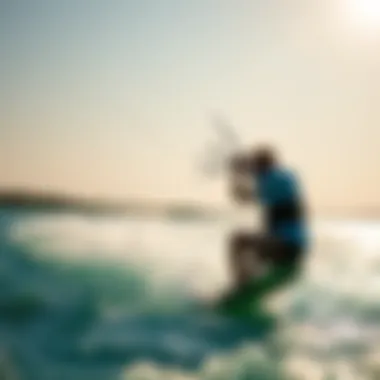
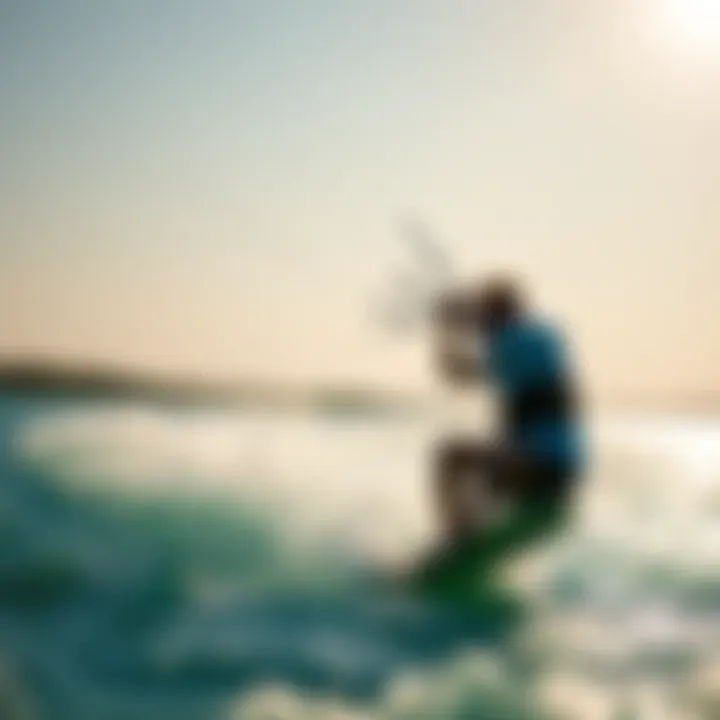
Understanding the design features of the Litewave Wing is pivotal for anyone venturing into the kiteboarding world. With its intricate blend of materials, shapes, and sizes, these elements collectively enhance performance, ensuring that whether you're a seasoned pro or a curious beginner, you can ride the waves with confidence and style.
Material Specifications
The materials used in the construction of the Litewave Wing play a crucial role in its durability and performance on the water. Most notably, it often incorporates ripstop polyester or nylon, renowned for its resistance to tearing and lightweight properties. This ensures that the wing maintains its integrity even in high winds. Moreover, the use of high-quality bladders usually made from TPU (thermoplastic polyurethane) enhances air retention, making it less prone to punctures.
What’s more, the stitching is meticulously reinforced to bear the stresses of dynamic movements, which is necessary when riding across choppy waters or catching waves. Due to these careful material choices, the Litewave Wing stands out, providing both longevity and high performance.
Key Benefits of Material Specifications:
- Durability: High-quality fabrics withstand harsh conditions and prolonged use.
- Lightweight: Essential for ease of handling and efficient transportation.
- Air Retention: High-performance bladders reduce maintenance time and enhance overall reliability.
Wing Shape and Structure
The unique shape of the Litewave Wing significantly affects its performance. The wings are engineered with a balance of aspect ratio that ensures both stability and lift. Generally, a higher aspect ratio offers better performance in terms of speed and efficiency, allowing skilled riders to harness the wind with finesse.
Furthermore, the profile of the wing is tailored to facilitate smooth transitions between flights and landings, contributing to a seamless riding experience. Its design does not only cater to speed but also plays a role in maneuverability, making sharp turns and jumps feasible – essential for kiteboarders looking to push their limits.
Important Aspects of Wing Shape:
- Aspect Ratio: Influences lift and speed; higher ratios yield better performance at a cost of stability.
- Profile Design: Aids in maintaining flow and reducing drag during operation, enhancing efficiency.
Size Variations and Their Implications
One of the most intriguing features of the Litewave Wing is its size variations. Riders can choose from a range of sizes to match their individual skill levels, riding style, and the wind conditions at play. Smaller wings tend to be faster and more agile, ideal for experienced riders. Larger wings, on the other hand, provide more power and easier handling, which is often beneficial for beginners or those riding in lighter winds.
Understanding size implications is fundamental. For instance, selecting a wing that is too small for the prevailing conditions can lead to underperformance, while a wing that is too large may become cumbersome and difficult to control.
Size Selection Considerations:
- Wind Conditions: Choose a size that aligns with average wind speeds in your preferred riding location.
- Rider Skill Level: Beginners benefit from larger wings that provide more lift, while experts may prefer smaller wings for speed and agility.
"Selecting the right size not only enhances performance but can make or break your entire kiteboarding experience."
In summary, the design features of the Litewave Wing are multidimensional, ensuring that users can optimize their kiteboarding experience. The careful balance of materials, wing shape, and size variations reveals the intricacies that enhance user performance in diverse conditions.
Performance Characteristics
The performance characteristics of the Litewave Wing play a pivotal role in its overall functionality and user experience in kiteboarding. These specifications not only outline the capabilities of the wing but also provide insights into how it adapts to varying conditions and rider preferences. Understanding these elements helps kiteboarders enhance their techniques and tackle challenges effectively.
Wind Range and Efficiency
The wind range of the Litewave Wing is a crucial factor to consider, as it influences how well the wing performs in different wind conditions. Typically, a broader wind range allows for optimal usage without the need for frequent wing changes. Riders should look for wings that operate efficiently across varying wind speeds, ensuring they can maximize their time on the water.
Efficient wings maintain stability while generating sufficient lift even in lighter winds. This can be particularly useful for beginners who are still mastering their skills. Kiteboarders often find that having a wing capable of performing well low on the wind spectrum broadens their options, allowing for a more versatile and enjoyable experience.
"A wing that excels in a wider range of wind conditions becomes your best friend. It keeps you gliding, even when the breeze dances lightly on the water."
Lift and Stability
Lift and stability are intertwined crucial aspects that determine how the Litewave Wing behaves on the water. Lift refers to the wing's ability to rise against gravity, which is pivotal for aerial maneuvers and freeing up the rider for tricks or smooth gliding. Stability, on the other hand, affects how securely the rider feels while on the wing, particularly during gusts or shifts in wind direction.
A well-designed wing will utilize its shape and materials to create an efficient lift-to-drag ratio. The Litewave Wing achieves this through aerodynamic design, allowing riders to handle higher speeds while retaining stability. This harmony between lift and stability is vital for maintaining control during rides, especially for those challenging themselves with advanced techniques. Riders often comment on how certain wings can feel “solid” during flights, thanks to their stability, making them more confident as they progress.
Control and Maneuverability
Control and maneuverability are often what separate a beginner from an experienced kiteboarder. The Litewave Wing offers excellent responsiveness to rider inputs, permitting easy adjustments in direction and stance. This responsiveness is largely due to the wing's design and how it interacts with the water and air.
An adaptable wing allows riders to execute sharp turns and precise movements, essential for navigating around obstacles or when adjusting to the wave patterns. Maneuverability becomes paramount in crowded locations where swift movement can help avoid hazards.
Features such as adjustable handles and variable wing shapes contribute to how effectively a rider can steer the wing. Control, particularly in dynamic conditions, can influence performance outcomes significantly, leading to safer and more enjoyable kiteboarding experiences.
In summary, performance characteristics such as wind range, lift and stability, and control and maneuverability all contribute to making the Litewave Wing a formidable choice for riders of all skill levels. Understanding these aspects deeply helps kiteboarders choose the right equipment and refine their skills on the water.
Usage Insights
Usage insights into the Litewave Wing can really make or break a kiteboarding experience. Understandably, every kiteboarder seeks the best conditions and techniques to enhance both safety and performance. When riders grasp the nuances of using their Litewave Wing, they can significantly elevate their rides and enjoyment out on the water. This section dives deep into the essential principles that maximize the effectiveness of the Litewave Wing.
Ideal Conditions for Use
Utilizing the Litewave Wing effectively hinges on recognizing the ideal conditions for its operation.
- Wind Speed: Optimal wind speeds for the Litewave Wing often hover around 12 to 25 knots. Within this range, the wing operates efficiently, offering a balance of lift and stability. Too little wind, and the rider may struggle to gain traction; too much, and it may become unwieldy.
- Water State: Flat water conditions lend themselves well to riding with the Litewave Wing. On the other hand, choppy water can complicate control and impact the overall experience. Beginners should seek calmer waters to gain confidence before tackling rougher conditions.
- Temperature: While the Litewave Wing is adaptable, consider the gear you wear. Cooler waters necessitate suitable wetsuits to ensure comfort and prevent hypothermia. On the contrary, warmer temperatures allow for lighter attire, enhancing mobility.
Choosing the right conditions not only ensures safety but futhers promotes the joy of riding.

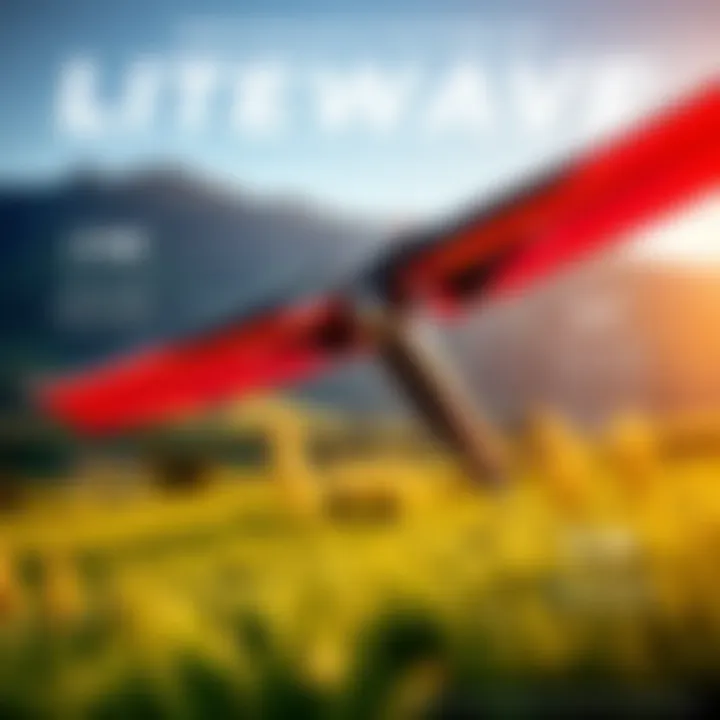
Riding Techniques with the Litewave Wing
Mastering riding techniques with the Litewave Wing involves finesse and understanding of its unique mechanics. Here are some key techniques that can help you get the most out of your sessions:
- Starting Out: Position yourself facing into the wind, holding the wing at a low angle to catch the breeze. This setup helps you lift off smoothly without unnecessary power.
- Steering: Unlike traditional kites, the Litewave Wing utilizes a different steering method. Lean in the direction you want to go while shifting weight from heel to toe to guide the wing's movement. It takes practice, but it turns into second nature over time.
- Balance and Control: Your ability to stand on the board and maintain a low center of gravity goes a long way. Bend your knees slightly and expect to adjust your body as the wind picks up or dies down.
- Transitioning: Carrying out smooth transitions is critical. As you change direction, control the wing and adjust your body position in sync. This synchrony can make your ride feel seamless.
These techniques ensure that you can harness the full potential of the Litewave Wing, providing a more fluid ride.
Common Mistakes to Avoid
In the pursuit of mastering the Litewave Wing, many riders fall into a few common pitfalls that can hinder performance and enjoyment. Avoiding these mistakes can save both time and frustration:
- Over-Inflating: A tight wing may sound like a good idea to maximize performance, yet it can compromise durability and handling. Always adhere to manufacturer guidelines for inflation.
- Neglecting Maintenance: Failing to check for wear and tear can lead to an equipment malfunction at the worst possible moment. Regularly inspect your wing, lines, and board for damage before heading out.
- Ignoring Wind Shifts: Failing to read changes in wind patterns can spell trouble. Always keep an eye on the horizon, and trust your instincts when conditions change unexpectedly.
- Overconfidence: Every rider has a limit. Understanding your skill level and being realistic can prevent dangerous situations, especially in challenging conditions.
By being aware of these common missteps, kiteboarders can navigate more smoothly through their sessions with the Litewave Wing. This knowledge ultimately makes for safer and more enjoyable experiences on the water.
Comparative Analysis
Understanding the comparative analysis of the Litewave Wing in contrast to both traditional wings and other competing models serves an essential role in grasping its unique qualities and advantages. This section is tailored to explore not just surface-level differences, but also deeper implications regarding performance, usability, and rider satisfaction. A thorough examination in this domain can guide kiteboarders in making an informed decision about their equipment, ultimately affecting their performance on the water.
Litewave Wing vs. Traditional Wings
When pitting the Litewave Wing against traditional wings, several distinctions become evident. Traditional wings often come with a more rigid construction and can sometimes feel cumbersome. In contrast, the Litewave Wing offers a more flexible and responsive feel during riding. This flexibility allows for a greater ability to adapt to changing wind conditions and provides enhanced maneuverability, which is a potentially game-changing aspect for enthusiasts seeking that edge.
- Performance in Varied Winds: Unlike traditional wings that struggle in lighter winds, the Litewave Wing truly shines, allowing for longer rides even when the breeze drops.
- Weight Consideration: The Litewave Wing weighs significantly less than many older models, meaning less fatigue over extended sessions on the water.
- User Experience: Riders frequently mention that using the Litewave Wing can feel more intuitive. When you crank turns, the responsiveness is impressive, something that traditional setups may lack.
These distinctions lead to a more engaging and appealing experience for the rider, showcasing why many are shifting towards newer designs.
Evaluating Other Brands and Models
In the diverse marketplace of kiteboarding equipment, evaluating other brands and models is critical when looking into the Litewave Wing. Competitors such as F-One, Duotone, and Slingshot vary in design philosophies and applications. By analyzing these alternatives, kiteboarders can appreciate what makes the Litewave Wing truly distinctive.
Here are some points of consideration:
- Innovation vs. Tradition: Some brands stick to tried-and-true methods, while others, like Litewave, often embrace newer technologies. This may alter not only the feel on the water but also durability and maintenance costs over time.
- Features to Look For: Key features such as lightweight materials, ease of inflation, and responsiveness are often benchmarks to assess. Riders should ask themselves: Does the alternative model match up to those features found in the Litewave Wing? Some brands may offer solid performance but lack the innovative designs of Litewave.
- User Reviews and Experiences: Platforms like Reddit and specific kiteboarding forums can provide a wealth of real-world data. Listening to fellow riders' feedback about their experiences with different brands can inform decisions and highlight potential pitfalls worth avoiding.
"Choosing a wing isn't just about what looks best. It’s about how it feels in your hands and beneath your feet."
Ultimately, this comparative analysis underscores a vital understanding of the landscape in kiteboarding technology, making it easier for enthusiasts to navigate their choices confidently. By diving deep into the nuances, one can truly appreciate how the Litewave Wing stacks up against its competitors and why it may be the right choice for varying riding styles and conditions.
Safety Considerations
Safety is the cornerstone of any adventure sport, and kiteboarding is no exception. With the power of wind propelling through a wing, there lies potential for both exhilarating fun and unexpected hazards. Understanding the safety aspects of using the Litewave Wing is paramount for both novice and experienced kiteboarders alike.
By embracing key safety measures, participants can significantly enhance their enjoyment while minimizing risks. It is more than just being cautious; it’s about cultivating a mindset that prioritizes safety as an integral part of the sport itself.
Essential Safety Practices
Before hitting the water with your Litewave Wing, a plethora of safety practices should be at the forefront of your preparations.
- Equipment Inspection: Each session should begin with a thorough inspection of your gear. Inspect the wing for tears, the lines for frays, and the board for damages. Just as one would check a car before a road trip, your kiteboarding equipment needs the same respect.
- Wear Proper Gear: A life jacket, helmet, and impact vest help shield against unforeseen incidents. Hats and sunglasses also play their part by protecting against sun rays and glare. Safety isn’t a hindrance; it’s a worth-while investment in your health.
- Know the Conditions: Familiarize yourself with the local weather conditions and tide patterns. High winds, unpredicted storms, or rapidly changing tides can pose significant threats. Always check reliable forecasts and heed any warnings.
- Buddy Up: When possible, kite with a friend. Not only is this more enjoyable, but having someone nearby can be crucial in emergencies. Should something go south, having an extra pair of eyes on the lookout can be the difference between safety and injury.
Adopting these practices lays the groundwork for a secure kiteboarding experience.
Emergency Protocols in Kiteboarding
Even with the best-laid plans and precautionary measures, emergencies can arise during kiteboarding. The waves can be unpredictable, and the winds can change in the blink of an eye. Thus, having a clear, well-communicated protocol for potential emergencies could save lives.
- Ascertain the Situation: Stay calm and assess your surroundings. Panic rarely leads to clarity. If you find yourself in turbulent waters, check if you’re tethered to the board or the wing, and act accordingly.
- Signal for Help: If you find yourself in need of assistance, waving your arms or using a whistle can alert others to your predicament.
- Water Drills: Familiarize yourself with self-rescue maneuvers. These drills can drastically improve your chances of getting to safety without needing outside help. There’s no harm in practicing drills on less windy days to feel comfortable with your responses.
- Rescue Systems: Use leash systems wisely. Understanding how to detach from your wing in an emergency can prevent entanglement and allows for a quick escape from danger.
"Preparation is half the battle. While spontaneity adds thrill, be prepared to handle whatever nature throws your way."
Ultimately, understanding and implementing these emergency protocols allows kiteboarders to navigate challenges more effectively. Being prepared for the unexpected isn’t merely an option; it’s an essential component of a fulfilling kiteboarding experience.
Emphasizing safety practices and preparing for emergencies can not only protect individuals but also foster a culture of safety within the kiteboarding community at large.
Environmental Aspects
In recent years, the conversation around environmental issues has grown substantially, impacting various sports, including kiteboarding. The environmental aspects of kiteboarding gear, such as the Litewave Wing, play a pivotal role in ensuring that enthusiasts enjoy their passion while minimizing their footprint on the planet. This section will delve into the sustainability of kiteboarding equipment and examine the broader implications of the sport on marine environments.
Sustainability in Kiteboarding Gear
The quest for sustainability in kiteboarding gear is not just a trend; it’s a pressing necessity. Manufacturers are increasingly aware of their responsibility toward environmental preservation. Sustainable materials are being employed to make kiteboarding gear more eco-friendly. Here are some of the exciting avenues being explored:
- Recycled Materials: Many brands are now incorporating recycled plastics and fabrics into their designs. This reduces waste and lessens the dependency on virgin resources.
- Biodegradable Components: Innovations in material science have led to the development of components that break down more effectively than traditional materials, which can linger in the environment for decades.
- Efficient Production Processes: Techniques such as waterless dyeing and energy-efficient manufacturing processes help decrease the carbon footprint associated with producing kiteboarding equipment.
By adopting these practices, the kiteboarding community can minimize its negative environmental impact while enjoying the thrill of the sport. Enthusiasts should consider brands that prioritize sustainability, aligning personal values with purchasing decisions.
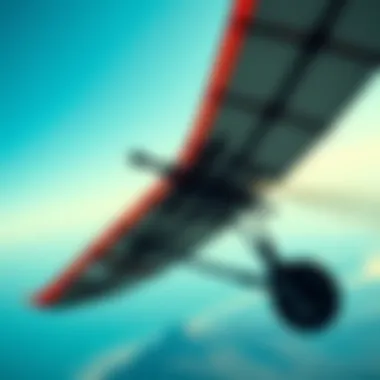
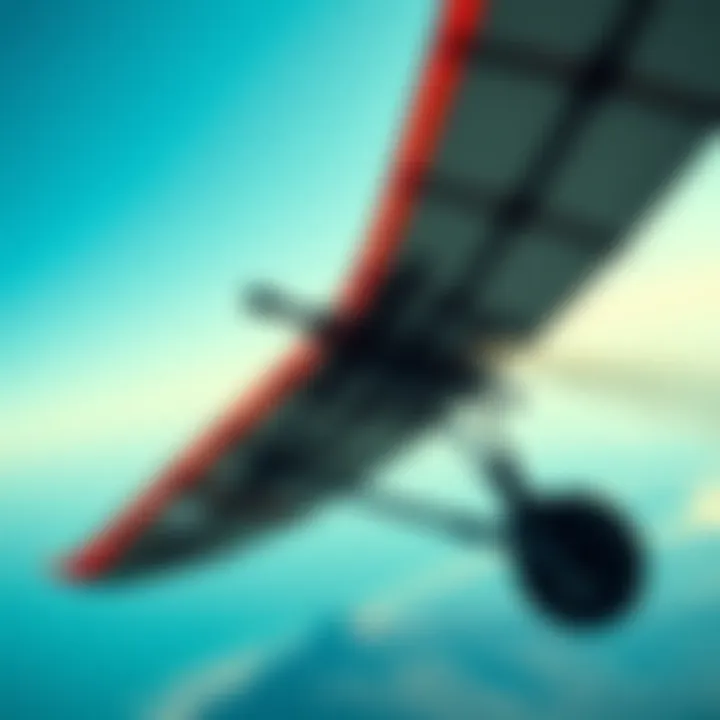
Impact of Kiteboarding on Marine Environments
While kiteboarding can be exhilarating, its presence on coastlines and in open waters does carry some environmental challenges. Recognizing these challenges is paramount for both current and future kiteboarders. Here are some of the impacts to consider:
- Ecosystem Disruption: Kiteboarding can physically alter marine ecosystems, mostly in shallow waters where sea grasses and coral reefs flourish. Care should be taken to avoid sensitive areas, as repeated use can lead to habitat degradation.
- Wildlife Disturbance: The noise and movement associated with kiteboarding can disturb local wildlife, particularly birds and marine mammals that rely on calm environments for breeding and feeding.
- Pollution: Whether it's the use of non-biodegradable equipment or litter from users, kiteboarding can contribute to coastal pollution. Every kiteboarder has a responsibility to leave the beach cleaner than they found it.
"It is not just about the thrill of riding but how we ensure that the natural playground remains intact for generations to come."
Minimizing these effects can require a commitment from users. Best practices can include:
- Staying informed about local regulations and ecosystems.
- Participating in beach clean-ups to help mitigate pollution.
- Educating fellow enthusiasts on the importance of respecting marine life and habitats.
Community and Culture
Understanding the community and culture surrounding kiteboarding is essential when exploring the Litewave Wing. This aspect not only shapes the experiences of riders but also influences the evolution of equipment design, like that of the Litewave Wing. Community ties play a significant role in fostering growth, knowledge sharing, and the overall enjoyment of the sport.
Kiteboarding, often regarded as a niche sport, thrives on the connections between enthusiasts, instructors, and event organizers. These connections create camaraderie among riders, promoting a culture that celebrates both individual skill and collective achievements. The passion for kiteboarding goes beyond just riding the waves; it brings together friends, families, and even entire neighborhoods, often turning beaches into vibrant social hubs.
Global Kiteboarding Events and Gatherings
Global events such as the Kite World Cup or the Red Bull King of the Air draw kiteboarders from all corners of the globe. These gatherings serve not just as platforms for competition but as large-scale celebrations of the sport.
- Networking Opportunities: Events allow newcomers to mingle with seasoned riders, instructors, and manufacturers. For example, the Kite Beach Festival in Cape Town brings thousands of enthusiasts together. Riders can learn and share tips while observing top talent in action.
- Demonstration of Equipment: Events play a pivotal role in showcasing innovations like the Litewave Wing. Many manufacturers set up booths to allow test rides, giving riders a hands-on experience with new gear.
- Workshops and Clinics: Participating in workshops hosted by experienced riders or brand representatives can enhance one’s skills efficiently. Topics often range from basic techniques to advanced maneuvers.
The unique atmosphere at these events not only strengthens the ties within the kiteboarding community but also fuels the cultural aspects of the sport. Sometimes, these events are coupled with environmental campaigns, emphasizing the importance of preserving the beautiful landscapes that kiteboarders cherish.
User Testimonials and Reviews
Hearing firsthand accounts from users of the Litewave Wing adds significant depth to understanding its impact. Riders often share their experiences in forums and social media, helping build a culture of feedback and improvement. Testimonials highlight not only personal achievements but also common challenges.
- Satisfaction with Performance: Many riders note how the Litewave Wing excels in varying wind conditions, providing them with a sense of freedom and control. One user states, > "I have never felt such stability when tackling strong winds, it's like dancing on water."
- Learning Curve: Reviews frequently mention the user-friendliness of the Litewave Wing. For newcomers, the transition from traditional wings to Litewave’s design can feel less daunting. One user shared, "I picked up the basics much faster than I did with my last wing."
- Durability and Design: Riders often commend the build quality of Litewave products, sharing that the attention to detail withstands the rigors of frequent use. Active users can provide insights about wear and tear, longevity, and ease of maintenance.
In sum, the broader kiteboarding community—through events and personal narratives—enhances the understanding of gear like the Litewave Wing. The shared experiences not only elevate individual riders but also contribute to the ongoing evolution of kiteboarding culture.
Future Trends in Kiteboarding Technology
The world of kiteboarding is on the cusp of an exciting evolution, as the technology behind it continues to rapidly progress. Understanding future trends in this dynamic sport is not merely about keeping up with gadgets; it's about grasping how these innovations can fundamentally alter the kiteboarding experience. From wing design to material innovations, every trend carries implications that could benefit both seasoned professionals and novices alike.
Innovations in Wing Design
As the core element of kiteboarding, the wing's design isn't just a matter of aesthetics. Innovations here directly impact performance, controlling everything from speed to maneuverability. For example, some manufacturers are exploring the use of adaptive wing profiles that can change shape based on wind conditions. Imagine controlling a wing that narrows or expands with just a flick of your hand! This responsiveness could mean better handling as the wind shifts, allowing for smoother rides in unpredictable conditions.
Additionally, we are observing the integration of smart technology into wing design. Sensors embedded within the wing could analyze environmental conditions and give feedback to the rider. Such tech could optimize movement, providing realtime data on speed, wind direction, and even suggesting adjustments to enhance performance.
Moreover, the design language is becoming more user-centric. Brands are focusing on making wings that are not only efficient but also easy to set up and use. Ease of storage and transport is becoming increasingly important for kiteboarders who travel. For example, a wing that can quickly collapse down into a compact form without sacrificing performance is a major plus.
Projected Developments in Materials
The materials used in kiteboarding gear have always been a critical factor in both performance and safety. As we head into the future, expect to see developments that not only enhance durability but also boast lighter weights. Innovations in fabrics like ripstop nylon and reinforced polyester are paving the way for wings that can withstand harsh conditions while remaining ultra-light.
Moreover, sustainable materials are grabbing attention too. There’s a growing awareness in the kiteboarding community regarding environmental impact. Manufacturers are exploring options like recycled materials and plant-based alternatives to reduce their carbon footprint. Making a kite from responsible materials is no longer just an afterthought; it is becoming integral to a brand's identity.
In addition to sustainability, many researchers are looking to incorporate nanotechnology into kiteboarding materials. This could lead to wings that are not only lighter but also more resistant to wear and tear, prolonging their lifespan significantly. What was once a niche technology is slowly creeping into mainstream use, promising to change how we think about the durability of our gear.
"As kiteboarding evolves, embracing sustainability and advanced materials will shape the future of the sport."
The trends in materials and technology indicate that the future of kiteboarding is not just about performance, but also about how the industry can be responsible and innovative. Kiteboarders now have more options than ever before, and with the right gear, they can push boundaries previously thought impossible. Keeping an eye on these trends means being prepared for a future that's more exciting and environmentally friendly than ever.
The End
As we reach the end of our detailed look into the Litewave Wing, its significance in the kiteboarding world becomes abundantly clear. The conclusions drawn here encapsulate not only the performance and design of the Litewave Wing, but also the broader implications for enthusiasts and professionals alike. Understanding its intricacies is paramount for optimizing your kiteboarding experience.
There are several key elements to consider:
- Performance Adaptability: The Litewave Wing's design allows for a range of wind conditions, showing its capability to handle everything from gentle breezes to more challenging gusts. This versatility means that kiteboarders can use the wing in various environments, expanding their opportunities for adventure.
- User-Friendly Features: The incorporation of intuitive control mechanisms caters to both newbies and veterans in the sport. Features such as easy inflation and deflation processes streamline the setup time, allowing users to get to the good stuff—actually riding!
- Technological Advancements: The latest innovations featured in the Litewave Wing can’t be overlooked. Riding this wing means riding on the crest of technology, giving users a competitive edge and providing more immersive and thrilling experiences.
Through this exploration, the Litewave Wing has proven to be not just a piece of equipment, but a gateway to enhancing overall kiteboarding proficiency and enjoyment. Its design and performance align seamlessly with modern kiteboarding demands, making it an invaluable asset to those serious about the sport.
Recap of Key Points
In wrapping up, let’s quickly revisit the cornerstone features.
- Current Performance Characteristics: We've highlighted its wind range capabilities, lift, and stability dynamics.
- Design Aspects: Material specifications and wing structure that bolster performance were discussed, along with how different size variations serve distinct riding styles.
- Usage Insights: Ideal riding conditions and common pitfalls to avoid were essential themes that any kiteboarder should keep in mind.
- Safety Protocols: Essential practices and emergency protocols emphasized the importance of being prepared while enjoying the thrill of kiteboarding.
The Future of the Litewave Wing and Kiteboarding
Looking forward, there are interesting developments on the horizon for both the Litewave Wing and kiteboarding as a whole. We can expect to see ongoing innovations not only in wing design—making them sleeker and more efficient—but also in materials used, pushing the durability and responsiveness of the wings.
Moreover, as the kiteboarding community grows, so will the emphasis on sustainability. Brands, including Litewave, may invest more in eco-friendly materials and practices to lessen their environmental impacts. This shift could redefine how kiteboarding equipment is produced, appealing to an increasingly environmentally-conscious consumer base.
Thus, the future appears bright for the Litewave Wing, poised at the cutting edge of technology and sustainability. It sets the stage for both thrilling rides and advancements in kiteboarding practices that benefit not just the rider, but also the planet.















